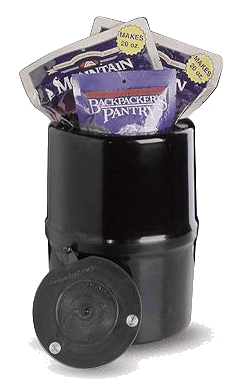|
Canisters versus Food Bags
 Bear canisters, or "bear cans" as they are usually called, are the best way to keep bears from stealing your food in the wild. These containers, which can be purchased from REI are odor-tight plastic containers that bears cannot open or break. Unfortunately, these canisters, which weigh about 3 pounds apiece, are cumbersome to carry and hold only small amounts of food. This makes it pretty hard to pack in enough cans to store all the food needed on long backpack trips. One solution is to keep a two-day emergency food supply in bear canisters, just in case a bear gets your main food cache, and keep the rest of the food in bear bags properly hung in a tree --- in other words counterbalanced from a suitable tree branch. Bear canisters, or "bear cans" as they are usually called, are the best way to keep bears from stealing your food in the wild. These containers, which can be purchased from REI are odor-tight plastic containers that bears cannot open or break. Unfortunately, these canisters, which weigh about 3 pounds apiece, are cumbersome to carry and hold only small amounts of food. This makes it pretty hard to pack in enough cans to store all the food needed on long backpack trips. One solution is to keep a two-day emergency food supply in bear canisters, just in case a bear gets your main food cache, and keep the rest of the food in bear bags properly hung in a tree --- in other words counterbalanced from a suitable tree branch.
Hanging food bags in trees is the time-honored system of protecting food in the wild. However, a smart bear will eventually figure out a way to steal any food left hanging in a tree, no matter how ingenius you think your hanging system is. Bears in places like Yosemite and Yellowstone are very smart, and they can drop food bags in record times. If you do decide to hang your food in a tree, then you need to make the food bags as difficult as possible to reach, and design an "early warning system" to alert you that a bear is in, or near, camp before he gets to the food. Once you discover a bear is near, then you can marshall your forces to scare the bruin away --- sometimes several times a night if the pest is persistent!
And bears can be very persistant. They are smart too. These are the reasons no food bag in the wild is safe. However, you can buy yourself time. Although a persistant bear will eventually chew through a four-inch branch holding food bags, this usually takes several hours. Female bears have been known to send their cubs up trees and out along the branches to drop down on food bags and fall with them to the ground, but this still takes at least several minutes before the bears have your food. The classic method of throwing a rope over a branch, hanging the food bag on one end of the rope, and tying the other end to another tree, buys you only a few seconds at best with a smart bear. All they need to do is follow the rope down to its tie-off point, cut the rope with a quick swipe of the paw, and down comes the food bag. If you are asleep when the deed is done, you have no chance of saving your food.
 Remember that possession is nine-tenths of the law. Once a bear has your food, the food belongs to the bear, and you are not getting it back! When you hike down the trail with your food in your pack and on your pack on back, you own it. When you take your pack off and leave it unattended, even for a few minutes at a potty stop, ownership of the food bag can change in the bear's favor in an instant. When food is properly hung, hopefully you have buy enough time to respond to a bear encounter, scare the pest away, and prevent the bear from getting your vittles. Remember that possession is nine-tenths of the law. Once a bear has your food, the food belongs to the bear, and you are not getting it back! When you hike down the trail with your food in your pack and on your pack on back, you own it. When you take your pack off and leave it unattended, even for a few minutes at a potty stop, ownership of the food bag can change in the bear's favor in an instant. When food is properly hung, hopefully you have buy enough time to respond to a bear encounter, scare the pest away, and prevent the bear from getting your vittles.
The Perfect Tree
- Find a tree with about a 4-inch diameter branch at the point where the branch joins the trunk. This branch should taper to about one-inch diameter around 20 to 25 feet from the trunk, thereby enabling you to counter hang the food bags 10 or more feet from the trunk. Remember that bears have been known to launch themselves throw the air from a tree trunk and land onto hanging food bags.
- The choosen branch should also sit about 25 feet off the ground so that the food bags will hang at least 12 feet above the ground, well beyond the reach of a standing bear.
- Select a tree in the middle of camp so that the bags hang no more than 20 feet away from the sleeping area. There is nothing wrong with sleeping right under the food bags, unless you are faint hearted. Bears are dangerous, but so is being caught in the wilderness with no food. Sleeping near the food bags lessens the response time for you to reach the food bags during a bear raid.
- A pile of rocks near your head when you bed down at night provides ammunition to deal with a bear encounter. However, take care not to hit the bear in the head if a rock-throwing melee begins. You only want to scare him away, not kill him. Pots and pans placed precariously around the base of the food tree makes an effective early warning system. Some outfits, REI is one, sell pepper spray especially made for warding off bears, assuming you are close enough and brave enough to spray the beast in the face.
| The perfect tree is seldom found, and compromise is always necessary. But the better the tree, the safer the vittles! |
Gear Needed for Counter Hanging Food Bags
- 50 feet of 6-mm (1/4-inch) diameter nylon rope. Use this as a "hang rope" to drape over a tree branch and hang the food bag from.
- 12 feet of 6-mm (1/4-inch) diameter nylon rope with a hook on one end (you can cut the hook off an old bungee cord). Use this as a "retrieval rope" to retrieve the food bags at dinner time.
- 25 feet of 3-mm (1/8-inch) diameter nylon parachute cord. Use this as a "throw cord" to hurl over the tree branch, then use this cord to drag the "hang rope" over the branch.
- A small nylon bag with a mini-biner. Use this as a "rock bag" to help get the "throw cord" over a tree branch.
- At least one standard-size carabiner, purchased from a local mountain shop, to attach ropes to the food bags. Another carabiner, though not necesssary, can make life easier.
- 2 or 4 food bags. These work best if they are outfitted with hauling and retrieval straps. For hauling, two straps, preferably with d-rings on the loose ends of each strap, should be sewn on opposite sides of each bag opening. A cobbler can do the sewing for you, or you can buy a fancy bear bag from REI. These straps are used to attach the bags to the hang rope. For retrieval, each bag needs a third strap attached across the bottom of the bag to provide something to grab onto when the bags are in the air.
If you don't want to sew hauling straps on your food bags, you can connect the food bags to the ropes using a knot known as a "larks head", another name for a "ring bend". However, a retrieval strap across the bottom of each bag IS A MUST!
Procedure for Counter Hanging Food Bags
- Find the perfect tree, coil the throw cord, put some rocks in the nylon bag, attach the cord to the bag with a mini-biner, and use the bag to hurl the cord over the branch.
- Once the throw cord is hanging over the branch, use the cord to drag the larger "hang rope" over the same branch. Coil the throw cord and put it and the nylon rock bag away when the hang rope is in place.
- Using the hook, attach the retrieval rope to the bottom of food bag #1. Attach bag #1 to one end of the hang rope (this is where that second carabiner can come in handy) using the straps and D-rings on top of the bag, then pull on the loose end of the hang rope to drag the food bag up off the ground until it touches the tree branch.
- Reach over your head and tie a loop in the hang rope. Then secure food bag #2 to this loop using a carabiner.
- Coil the loose end of the rope hanging off bag #2, and secure this coil to the bottom of the bag using the carabiner you placed there in the previous step. Make sure the coil is secure, lest a bear shake it loose. When the coil is in place, let go of the food bag and use the uncoiled retrieval rope on bag #1 (this should be the rope attached to bag #1 with the hook) to position the food bags overhead.
- A flick of the wrist should pull the hook off the bottom of bag #1 and leave both bags hanging free and counter balanced overhead. If the hook won't shake loose, then coax it out with a long stick and straighten it out a bit so that the problem dosen't repeat itself. Coil the retrieval rope and put it and the hook away.
- To retrieve the food bags, lash the hook of the retrieval rope to a long stick, reach the hook up, snag the strap on the bottom of food bag #2, and pull it down.
  With practice, you can counter hang food bags in 10 minutes or so. Retrieving or re-hanging bags should take less time. If more backpackers learned to use bear canisters and properly counter hang their food bags, then fewer bears would be able to steal people food, and the bears would be forced to search for their dinner in the wilds once more, as they used to in the days before city dwellers took to the trails. With practice, you can counter hang food bags in 10 minutes or so. Retrieving or re-hanging bags should take less time. If more backpackers learned to use bear canisters and properly counter hang their food bags, then fewer bears would be able to steal people food, and the bears would be forced to search for their dinner in the wilds once more, as they used to in the days before city dwellers took to the trails.
|


